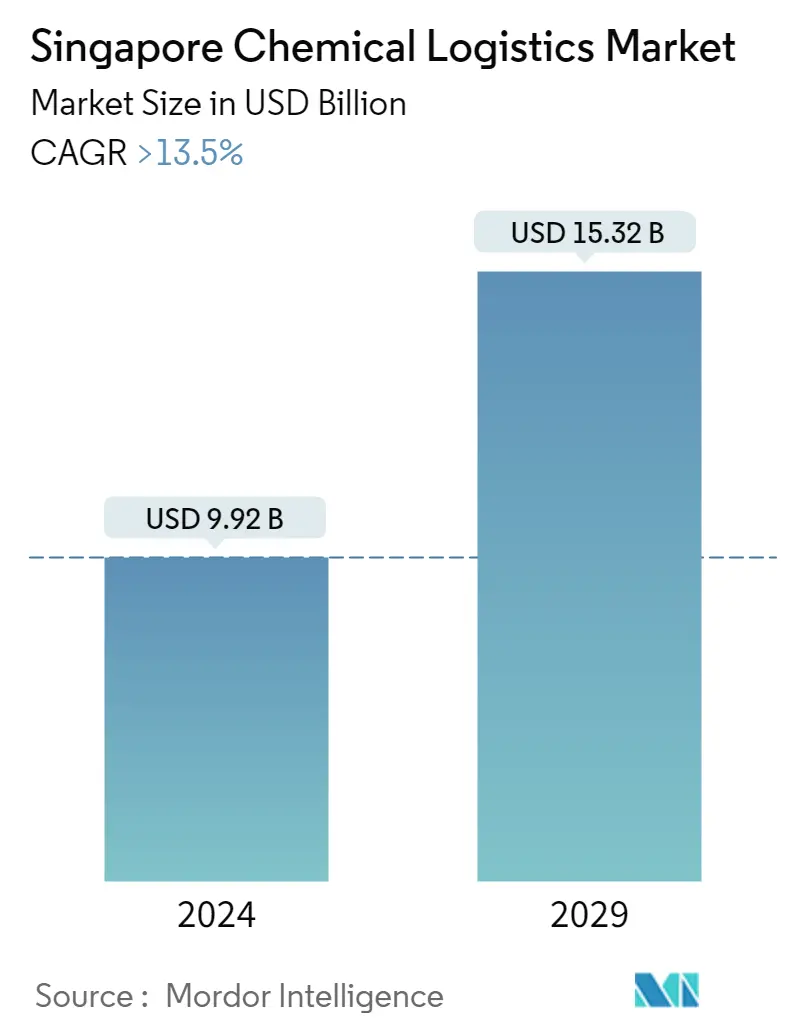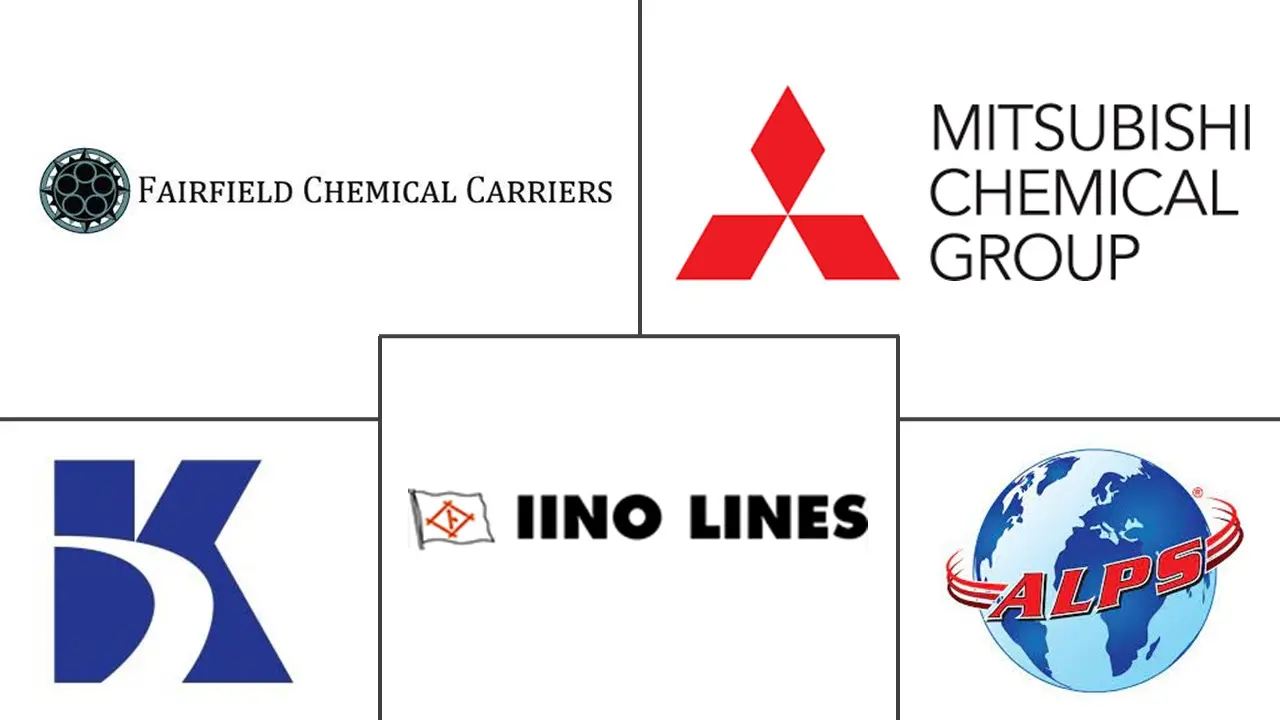Market Size of Singapore Chemical Logistics Industry

| Study Period | 2019 - 2029 |
| Base Year For Estimation | 2023 |
| Market Size (2024) | USD 9.92 Billion |
| Market Size (2029) | USD 15.32 Billion |
| CAGR (2024 - 2029) | > 13.50 % |
| Market Concentration | Low |
Major Players
*Disclaimer: Major Players sorted in no particular order |
Singapore Chemical Logistics Market Analysis
The Singapore Chemical Logistics Market size is estimated at USD 9.92 billion in 2024, and is expected to reach USD 15.32 billion by 2029, growing at a CAGR of greater than 13.5% during the forecast period (2024-2029).
- Singapore is one of the top energy and chemical centers in the world thanks to its potent combination of refining, olefins production, chemical manufacture, business, and innovation capabilities. Here are major activities for more than 100 international chemical companies. Singapore's main hub for petrochemical, specialty chemical, and refining operations is Jurong Island. Customers and suppliers are connected tightly by its highly integrated infrastructure, frequently literally over the fence through pipes. This integrated ecosystem, which includes utilities and logistical service providers, generates cost-saving production synergies for businesses. Investments totaling more than USD 37.27 billion have been made in Jurong Island. Singapore has positioned itself as a sustainable, highly productive base for chemical manufacture as the global industry evolves towards tailored blending and eco-friendly formulations.
- A new chemical warehouse and storage facility building is a very capital-intensive undertaking that necessitates adhering to a variety of criteria and acquiring approvals. Additionally, warehouses have very significant operational and maintenance costs. Due to the rising need for warehousing solutions, the sector is drawing a variety of investments. The efficient and effective operation of warehouses is a crucial duty, though. Some of the essential components needed for a practical and effective warehouse and storage facility are appropriate financial modeling, demand mapping, and infrastructural evaluations. The period needed to see a return on investment is lengthy since the cash involved in manufacturing and setting up a warehouse is irreversible. Consequently, the high expense of putting up and operating a warehouse and managing inventory loss is expected to limit the growth of the market during the forecast period.
- Even though Singapore is far from the European financial crisis, its chemical industry is directly affected by world events. It is dependent on the price of feedstocks because it is a close relative of the oil and gas sector, exposed to trade conflicts, and subject to changing consumer trends. Despite, and perhaps because of, the pandemic, almost all of the businesses GBR spoke to this year reported robust growth in the first quarter of 2022 and record-level growth in 2021. The future is uncertain, though, and depends on how well chemical companies can transfer costs to the next link in the value chain and ultimately to the customer.
- Performance chemicals are better positioned to pass on costs and generate healthy margins than bulk chemicals, which are directly impacted by rising feedstock and energy prices. The lack of available raw materials combined with ongoing logistical constraints has caused significant problems for companies in the specialty chemical industry, delaying orders and resulting in lengthy waiting lists for some items. The Singaporean sector is subject to the very good demographic fundamentals of Asia-Pacific in addition to the current market factors. The sector places a high priority on nutrition, with Singapore at the center of the fight against the difficulties of both food security and food sustainability.
Singapore Chemical Logistics Industry Segmentation
The process of organizing and controlling the movement of chemicals and related materials from suppliers to manufacturers and consumers is known as chemical logistics. This procedure guarantees that the appropriate chemicals are delivered to the appropriate locations at the appropriate times. Transportation, storage, inventory management, and security can all be part of chemical logistics. A complete background analysis of the Singaporean chemical logistics market, including the assessment of the economy and contribution of sectors in the economy, a market overview, market size estimation for key segments, emerging trends in the market segments, market dynamics and geographical trends, and COVID-19 impact, is covered in the report.
Singapore's chemical logistics market is segmented by service (transportation, warehousing, and other services), by mode of transportation (roadways, railways, airways, waterways, and other modes of transportation), and by end-user (pharmaceutical industry, cosmetic industry, oil and gas industry, specialty chemicals industry, and other end-users).
The report offers market size and forecast values (USD) for all the above segments.
| By Service | |
| Transportation | |
| Warehousing, Distribution, and Inventory Management | |
| Other Services |
| By Mode of Transportation | |
| Roadways | |
| Railways | |
| Airways | |
| Waterways | |
| Other Modes of Transportation |
| By End-User | |
| Pharmaceutical | |
| Cosmetic | |
| Oil and Gas | |
| Specialty Chemicals | |
| Other End-Users |
Singapore Chemical Logistics Market Size Summary
The Singapore chemical logistics market is a vital component of the global chemical industry, leveraging Singapore's strategic position as a leading energy and chemical hub. The market benefits from a highly integrated infrastructure, particularly in Jurong Island, which hosts numerous international chemical companies and facilitates close connections between customers and suppliers. This integration fosters cost-saving synergies and positions Singapore as a sustainable base for chemical manufacturing. However, the market faces challenges such as high capital and operational costs associated with new warehouse and storage facilities, which could impede growth. Despite these challenges, the sector is attracting investments due to the increasing demand for efficient warehousing solutions. The market's growth is also influenced by global events, trade conflicts, and the fluctuating prices of feedstocks, which impact the chemical industry's performance.
The Singaporean chemical logistics market is characterized by its fragmentation, with numerous local, regional, and global players contributing to its dynamic landscape. The market is witnessing significant growth in third-party logistics (3PL) due to the rising importance of technology in logistics, such as automation and data-driven solutions. This growth is further supported by the expansion of logistical infrastructures and the increasing import and export of raw materials. Major players in the market, including ALPS Global Logistics and Brenntag, are adopting innovative technologies like big data analytics and IoT to enhance operational efficiency. Additionally, the market is evolving with trends such as the use of green hydrogen in chemical production, reflecting a broader shift towards sustainability and advanced energy solutions.
Singapore Chemical Logistics Market Size - Table of Contents
-
1. MARKET INSIGHTS DYNAMICS
-
1.1 Current Market Scenario
-
1.2 Market Overview
-
1.3 Market Dynamics
-
1.3.1 Drivers
-
1.3.1.1 Increase demand of Petrochemical is driving the market
-
1.3.1.2 Increase in Investments is driving the market
-
-
1.3.2 Restraints
-
1.3.2.1 High Cost of Operations
-
-
1.3.3 Opportunities
-
1.3.3.1 Technological Innovations
-
-
-
1.4 Value Chain / Supply Chain Analysis
-
1.5 Porter's Five Forces Analysis
-
1.5.1 Bargaining Power of Suppliers
-
1.5.2 Bargaining Power of Buyers/Consumers
-
1.5.3 Threat of New Entrants
-
1.5.4 Threat of Substitute Products
-
1.5.5 Intensity of Competitive Rivalry
-
-
1.6 Technological Innovations in the industry
-
1.7 Government Initiatives to Attract Investment in the Industry
-
1.8 Insights into the 3PL Market (Market Size and Forecast)
-
1.9 Impact of COVID - 19 on the Industry
-
-
2. MARKET SEGMENTATION
-
2.1 By Service
-
2.1.1 Transportation
-
2.1.2 Warehousing, Distribution, and Inventory Management
-
2.1.3 Other Services
-
-
2.2 By Mode of Transportation
-
2.2.1 Roadways
-
2.2.2 Railways
-
2.2.3 Airways
-
2.2.4 Waterways
-
2.2.5 Other Modes of Transportation
-
-
2.3 By End-User
-
2.3.1 Pharmaceutical
-
2.3.2 Cosmetic
-
2.3.3 Oil and Gas
-
2.3.4 Specialty Chemicals
-
2.3.5 Other End-Users
-
-
Singapore Chemical Logistics Market Size FAQs
How big is the Singapore Chemical Logistics Market?
The Singapore Chemical Logistics Market size is expected to reach USD 9.92 billion in 2024 and grow at a CAGR of greater than 13.5% to reach USD 15.32 billion by 2029.
What is the current Singapore Chemical Logistics Market size?
In 2024, the Singapore Chemical Logistics Market size is expected to reach USD 9.92 billion.

